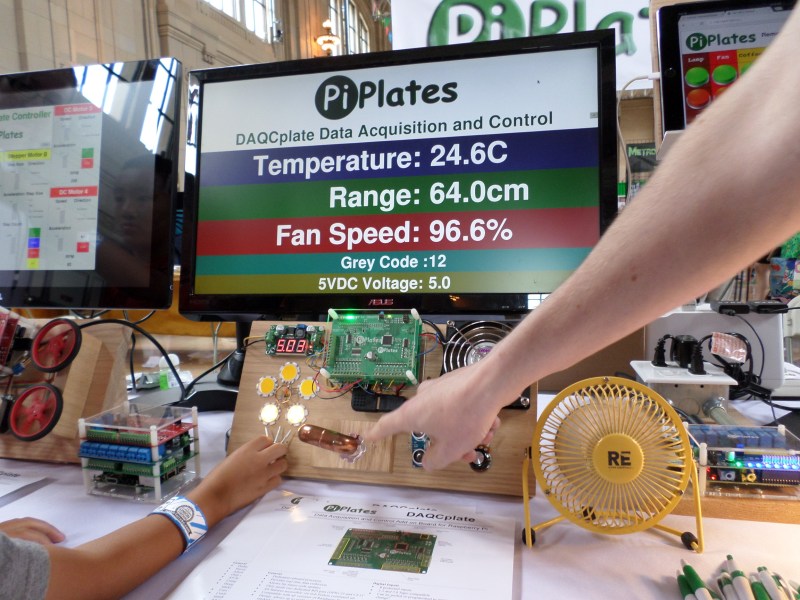As soon as he spied the Jolly Wrencher on my shirt, [Jerry Wasinger] beckoned me toward his booth at Kansas City Maker Faire. Honestly, though, I was already drawn in. [Jerry] had set up some interactive displays that demonstrate the virtues of his Pi-Plates—Raspberry Pi expansion boards that follow the HAT spec and are compatible with all flavors of Pi without following the HAT spec. Why not? Because it doesn’t allow for stacking the boards.
[Jerry] has developed three types of Pi-Plates to date. There’s a relay controller with seven slots, a data acquisition and controller combo board, and a motor controller that can handle two steppers or up to four DC motors. The main image shows the data acquisition board controlling a fan and some lights while it gathers distance sensor data and takes the temperature of the Faire.
The best part about these boards is that you can stack them and use up to eight of any one type. For the motor controller, that’s 16 steppers or 32 DC motors. But wait, there’s more: you can still stack up to eight each of the other two kinds of boards and put them in any order you want. That means you could run all those motors and simultaneously control several voltages or gather a lot of data points with a single Pi.
The Pi-Plates are available from [Jerry]’s site, both singly and in kits that include an acrylic base plate, a proto plate, and all the hardware and standoffs needed to stack everything together.
















That is cool.
I need a relay controller for a clock I want to make. Yes, I could use solid-state, but I love the sound of several relays switching all at once.
Awesome blossom.
We have come full circle:
https://wikipedia.org/wiki/PC/104
I don’t really know what you’re getting at, but fixed link.
https://en.wikipedia.org/wiki/PC/104
The cool part is the Pi is so much more capable than all the PC104 industrial stuff. and at 1/500th the price.
I get your point (and share your enthusiasm) but you’ve got to first define “capable.” All the horsepower in the world won’t help you if a machine is broken down. And in the industrial automation world, capable means reliability first. There is a lot more to an industrial PC than numerical performance; ruggedness is often the prime consideration, or at least as important as number crunching ability.
I’d give a Rpi on a typical factory floor or a steel mill anywhere from minutes to a few days, tops. RF noise, heat/cold, environmental contaminants (particulates/grit, cutting coolant spray in the air, solvents), vibration (THIS IS A BIG SOURCE OF FAILURES), dirty power/brownouts/spikes/unexpected shutdowns, etc. etc. etc. It’s a rough world and while those old industrial boxes aren’t sexy, they are dependable. Dependability carries a price and making a system that will tolerate wild swings of all the above isn’t easy.
Every minute that machine is down means thousands of $$s of lost productivity, and often these machines are simple controllers switching relays and running control loops. (think of the control systems running traffic lights at an intersection. Those cannot fail or behave unpredictably or else life is at risk. Or a factory — routing power, switching train cars, or controlling a robot.)
I love the rasp pi & what it enables, but it’s like comparing a sports car to a farm tractor. Each will excel in their own environment, but they are very different beasts built with very different goals.
The slow but steady aceptance/use of the metric system within the usa makes my heart warm. From a late 40s brit who despises the antiquated ‘imperial system’.
Mr. Spoon are you referring to the display that’s showing degrees in Celcius and distance in centimeters?